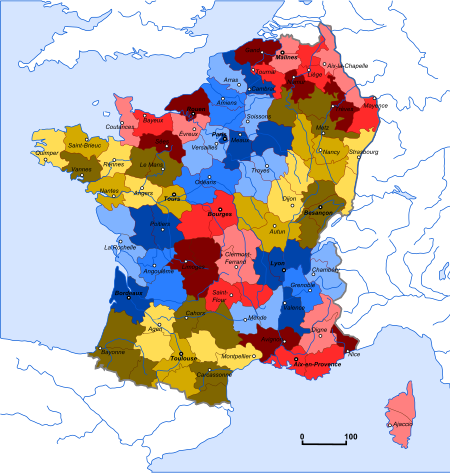Concordat of 1801

The Concordat of July 15, 1801 was a state church treaty between France and the Holy See . Napoléon Bonaparte ended the spiritual and secular struggle with the Catholic Church in his sense. The Catholic Church in France was divided into 59 dioceses for the next two decades , which were grouped into ten ecclesiastical provinces and also included areas that were already annexed.
Motifs
Napoleon had sought a settlement with Rome in order to counteract the suppression of Catholicism as a result of the French Revolution . On the one hand, he was motivated to make a name for himself as the first consul of the republic and, on the other hand, to express the end of the revolution through the coup d'état of 1799 in the ecclesiastical field.
Results
In this treaty, signed by Napoleon as representative of the First French Republic and Cardinal Ercole Consalvi as representative of Pope Pius VII , the Pope recognized the French Republic, the civil status of the Catholic Church and the dismissal of all bishops ordered by Napoleon .
Pius VII, who was later forced to participate in Napoleon's coronation as emperor in 1804 and who was to be taken prisoner in a dispute with the emperor from 1806 to 1814, assessed the situation from a real-political point of view , which is why he was ready to negotiate. In 1801 the Concordat was signed in Paris. In the preamble , the Catholic religion was referred to as that of “the great majority of French citizens”, although there was no mention of a state religion as before . The Concordat recognized the plurality of religious denominations, the freedom of worship and the republic as such.
Another result of the Concordat was that Napoleon's authority was strengthened. In addition, it created an order of church life up to the radical separation of state and church in 1905 and served as a model for other churches and countries. In Alsace and the Moselle department , it is still valid today, as these areas did not belong to France in 1905 and did not adopt the new law.
The “Organic Articles” of April 8, 1802 ( 18 germinal to X ) followed the Concordat as an implementing law. His 77 articles, which were not agreed with the Roman Curia , once again secured state prerogatives , i.e. the need for state approval for papal decrees . In addition, groundbreaking guidelines for the Catholic and Protestant church organization were laid down here.
gallery
Allegory of the Concordat
Web links
literature
- Andreas Roth : The Concordat of 1801. Becoming, meaning and effects , in: Walter G. Rödel (Ed.): Zerfall und Wiederbeginn. From the archbishopric to the diocese of Mainz (1792 / 97–1830). A comparison. Festschrift for Friedhelm Jürgensmeier , Würzburg 2002, pp. 103–124
- Rodney J. Dean: L'Eglise constitutionnelle, Napoléon et le Concordat de 1801 , Paris 2004 ISBN 2-7084-0719-8


